‘Touch’ is a complicated sense. When we casually speak of ‘touch,’ we are bundling together different information derived from separate types of receptors, each indicating a different property of an object in contact with our body. Much in the same way that we cannot readily separate the dimensions of acuity and color vision in our everyday visual experiences, it is difficult to make ourselves aware of the different dimensions of touch,
‘touch’ is the amalgamation of several different types of information or sensations. It is preferable, scientifically, not to refer to touch. Rather the term somatic sensitivity is used, and each type of sensitivity is described separately. Somatic sensitivities include pressure, skin stretch, vibration, noxious stimuli, and temperature. Each of these sensitivities involves different receptor types.
Quantitative studies on somatic sensitivities are very few. Therefore, much of what follows is based on rather broad generalizations. However, some intriguing examples of how birds employ information from somatic receptors will be discussed. It is clear that further research on the numbers, distributions and sensitivities of somatic receptors across bird species could throw up some fascinating findings on the sensory ecology of touch.
Somatic sensitivities
Different somatic receptors in the skin detect mechanical, thermal, and noxious stimuli outside the body. Classifications of somatic receptors are usually based on the stimuli they respond to rather than on their detailed structure.
Most of the recent and detailed studies on the form and function of somatic receptors in birds have concentrated on those found in the bills of certain species. This is partly because they are readily identified and located but, more importantly, because their function is key in the detection and identification of certain prey or food items.

Mechanoreception
Mechanoreceptors respond to the movements of an object or fluids with which they are in direct contact. Movements have different components: acceleration (vibration), velocity, and amplitude. Different types of mechanoreceptors respond to each aspect of movement separately. There are two main types of mechanoreceptors in birds, Herbst and Grandry corpuscles.
Herbst corpuscles
The most widely distributed mechanoreceptors in a bird’s body occur everywhere in the skin, the legs and wings’ bones, tendons, muscles, and joint capsules, and near large blood vessels.
Herbst corpuscles respond to rapid pressure changes and are regarded primarily as vibration detectors. They can respond directly to a rapidly vibrating stimulus in a one-to-one manner (each movement eliciting a separate signal) at frequencies between 100 Hz (cycles per second) and 1000 Hz.
It is in the bills of birds that the distribution and number of Herbst corpuscles show marked variations between species. High numbers and concentrations in particular locations along the bill are related to the way in which the bill itself is used as an exploratory device, especially during foraging.
Somatic receptors in shorebirds
In those species of shorebirds (Scolopacidae) that probe with long bills in mud or sand when foraging, the tip of the upper jaw bone may bear countless small pits packed with Herbst corpuscles. These high concentrations of somatic receptors are known as bill-tip organs, and they sit just below the soft skin which covers the outer surface of the bill in these shorebird species. Thus, they function through the skin.
How somatic receptors used in feathers
In feathered skin, Herbst corpuscles are located mainly at the bases of the feather follicles and bristles. These have been interpreted as a mechanism that detects the vibrations of feathers and bristles. They probably provide birds with information of the stresses on feathers, particularly as they move through air currents during flight, and also enable birds to detect objects that touch the bristles. This function may apply particularly to bristles around the mouth (rictal bristles) and enable adults to feed their young in the dark of a nest cavity.
Grandry corpuscles
These receptors primarily detect the velocity component of a moving object in touch with them. They are found particularly in feathered skin but also in the skin of the soft part of the bill covering of geese. Unlike Herbst corpuscles, they do not follow vibrations and are thought to be sensitive mainly to velocity. Movements that cause crumpling of the skin seem to be the main stimulus that causes these receptors to respond.
Thermosensitive receptors
Humans are readily able to detect a source of heat or cold, particularly on certain of our body surfaces. For example, we seem to be particularly able to detect the radiant heat from the sun falling on our backs or our face. This ability is due to what is termed thermosensitive units, which respond to both cold and warmth, and which can also respond to both the amplitude and rapidity of a temperature change.
Although the presence of such receptors has been demonstrated in very few species of birds, they may be widely distributed among all bird species. They seem to play a role in the control of behaviors involving the regulation of body temperature but are also probably involved in such behaviors as regulating nest temperature during incubation and chick rearing.
Cutaneous nociceptors
These somatosensory receptors are probably very important for the survival of all animals. They respond to the invasion of the body, for example, by cutting or pinching. In mammals, their response seems to directly elicit significant changes in the condition of the body, such as an increase in blood pressure, heart rate, or respiratory frequency, when the invasion is detected. Little is known about nociceptors in birds, but they have been identified in some species, and they probably have similar properties to those found in the skin of mammals.
Bill-tip organs
Bill-tip organs were first described in geese and ducks. Recent research has also described other types of bill-tip organs in kiwis, parrots, long-billed shorebirds, and ibises. All bill-tip organs are high concentrations of somatic receptors, mainly Herbst corpuscles arranged around the tips of the bill. The diverse groups of birds in which these organs occur, and the different arrangements of their receptors, indicate that bill-tip organs have evolved independently a number of times. In some species, the bill-tip organ extends along the bill towards its base.
The importance of bill-tip organs is that they turn the bill into a self-guided exploratory device. The bill does not need visual guidance for it to detect food items. Bill-tip organs in parrots allow them to use their bills to manipulate objects and as an extra’ limb’ for climbing. The presence of a bill-tip organ means that vision can be more fully devoted to vigilance and predator detection.
The bill-tip organs of ducks and geese
A cursory inspection of the bills of geese and ducks does not indicate that they might be particularly sensitive to touch. The outer surface at the tip of the upper bill, and the outer and inner surfaces of the lower bill, are hard and horny. However, looking at the rim of the inside of the bill reveals, even to the naked eye, small pits. These pits contain touch papillae that reach the surface and transmit mechanical information to clusters of Herbst and Grandry corpuscles embedded in the hard horn of the bill tip.
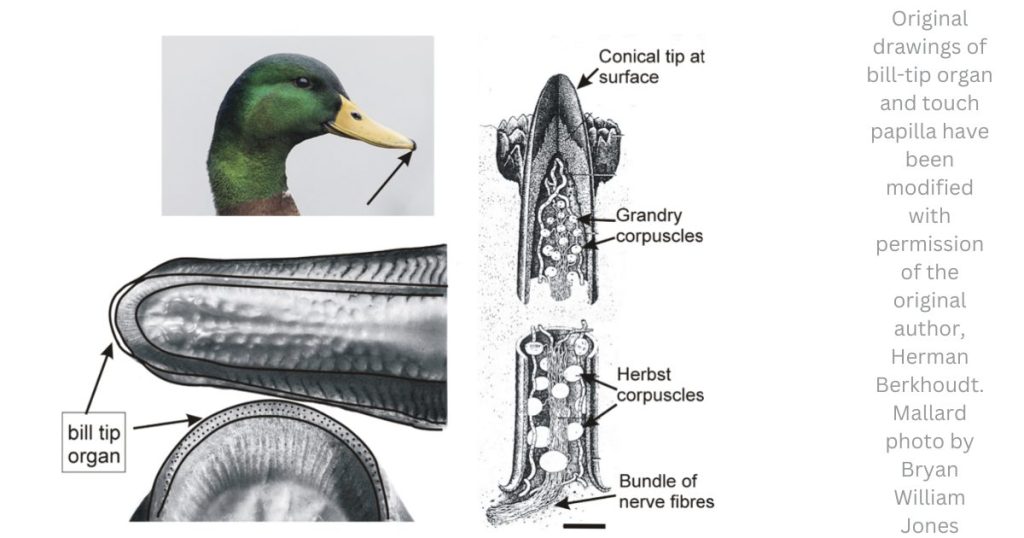
The bill-tip organs of parrots
Despite the general fascination with parrots, and their popularity as cage birds, it was more than a century before a further description of the bill-tip organ in a parrot was published. Even now, knowledge of parrot bill-tip organs remains rudimentary and lacks a comparative base.
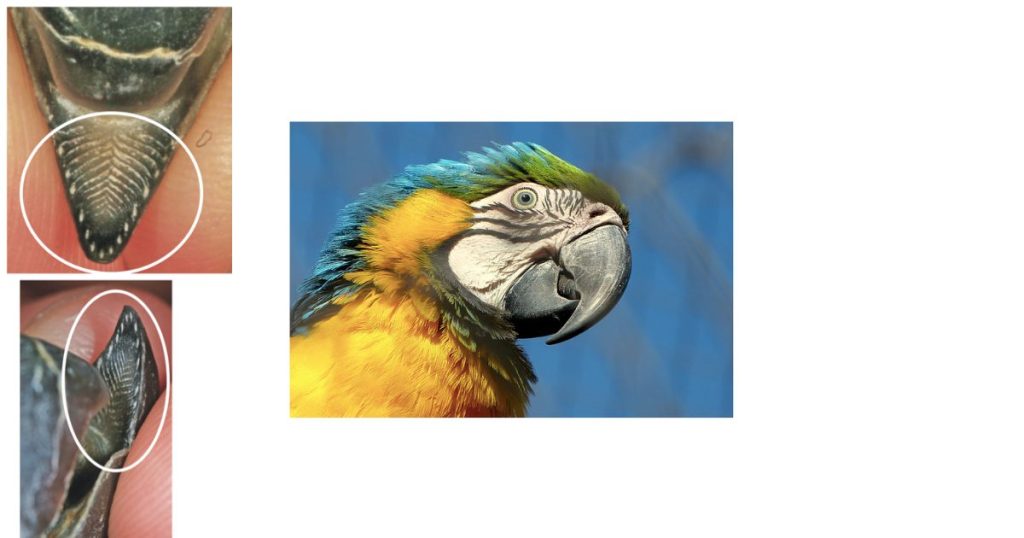
The bill-tip organs of parrots are very different from those of wildfowl. Rather than continuous rows of touch receptors arranged around the bill tips, the receptors in parrots occur in groups of discrete bundles. These are well separated from each other in a symmetrical pattern along the inside edges of the highly curved upper mandible.
The bill-tip organs of shorebirds, kiwis, and ibises
A third type of bill-tip organ occurs in shorebirds, kiwis, and ibises. Because of the disparate evolutionary origins of these taxa (kiwi and shorebirds last shared a common ancestor 70 million years ago), it seems highly likely that the similarity of these bill-tip organs is due to evolutionary convergence. They evolved separately as similar solutions to the sensory challenges associated with finding deeply buried prey items. Kiwi, shorebirds, and ibises all probe with their long thin bills into soft soil and mud in search of invertebrate prey.
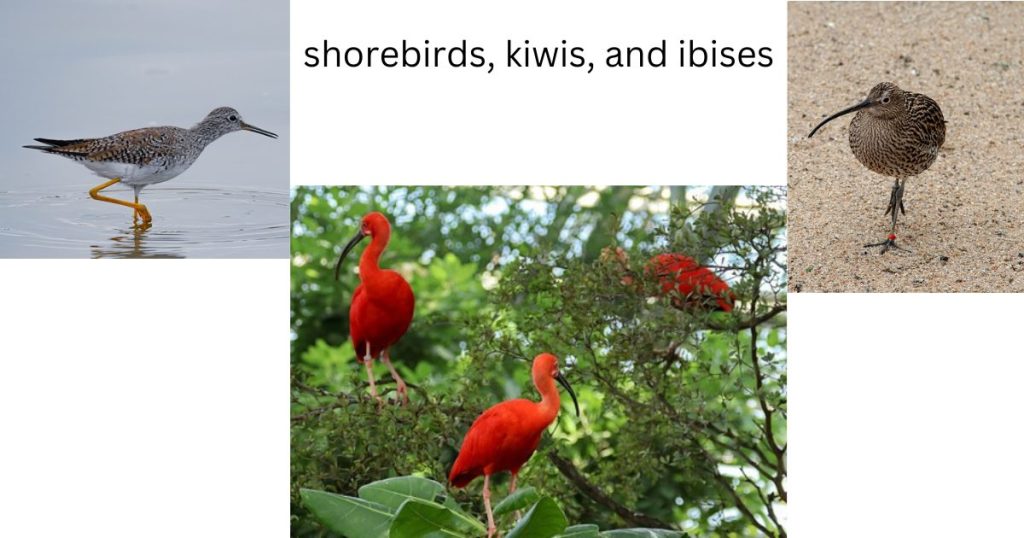
How bill-tip works
The function of these organs is best understood in shorebirds. It has been shown that their bill-tip organs are sufficient to locate prey and possibly identify it. The bill-tip organ provides information on the vibrations produced as prey moves within muddy and sandy substrates. The bill tip does not have to make direct contact with a prey item for its presence to be detected. This is because as the bill is thrust into wet mud or sand, it displaces water away. If this displaced water encounters an object, it creates back pressure, which can be detected by the organ. This ability has been given the name ‘remote touch‘ because back-pressure patterns are produced within a cylindrical volume around the bill tip, perhaps up to 10 mm from the bill. Further probing may be necessary to determine the exact position and identity of the object, but moving the bill around after inserting it may serve to locate the item, with the curvature of the bill helping to search a volume below the surface. The birds may detect a soft-bodied food item, such as a worm, or a hard one, such as a mollusc shell, and they may be able to find the difference between them without making direct contact.
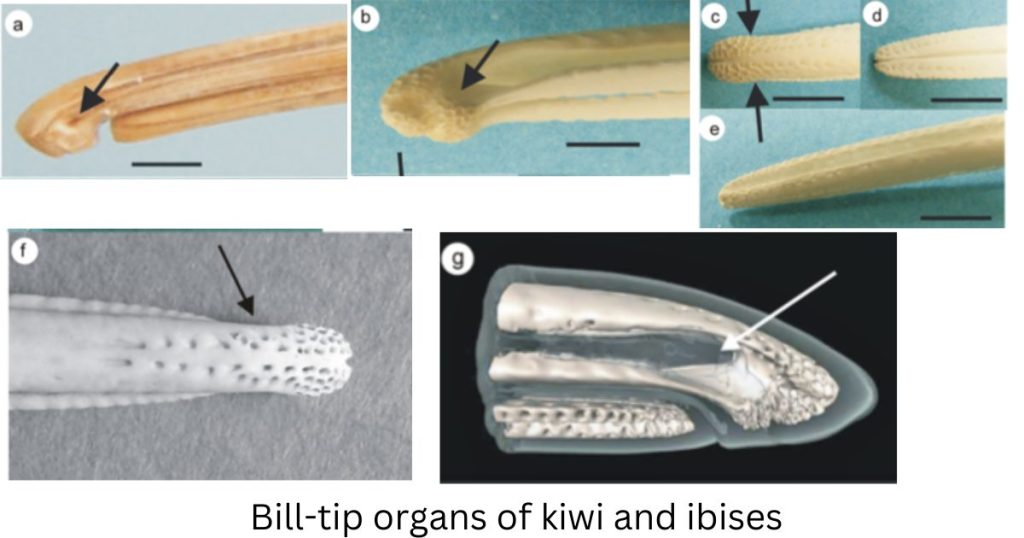
Ibises have bill-tip organs like those of shorebirds and kiwis.
The nervous system is responsible for all a bird sees, hears, smells, tastes, feels, thinks, and does. In other words, the nervous system transmits sensory stimuli, evokes appropriate motor responses, and regulates all internal body functions. The structural components of the nervous system are similar in all vertebrates, although they differ in complexity, and birds are on the higher end of this spectrum.
The central nervous system consists of the spinal cord and the brain;
Types of neurons:
There are two main types of neurons, distinguished by the direction and function of their impulses.
Sensory neurons:
It conveys impulses from all over the body to the (spinal cord and brain) central nervous system. These sensations may be triggered by conscious stimuli, such as visual food items, sounds of a predator, or pain from an injured wing. However, impulses may also be subconscious: muscles, tendons, and joints inform control centers of limb and muscle position via proprioceptive impulses.
Motor neurons:
It conveys impulses from the brain and spinal cord to stimulate muscle contraction or gland secretion. For example, food stimulates olfactory or visual nerves, which send an action potential to stimulate the brain, which then sends a command via motor neurons to the salivary glands in the mouth. Motor nerves are of vital importance to muscle health. For example, if a motor nerve leading to a skeletal muscle is cut or dies, the muscle will become paralyzed. Unless the nerve is able to regrow, this muscle will waste away over time.
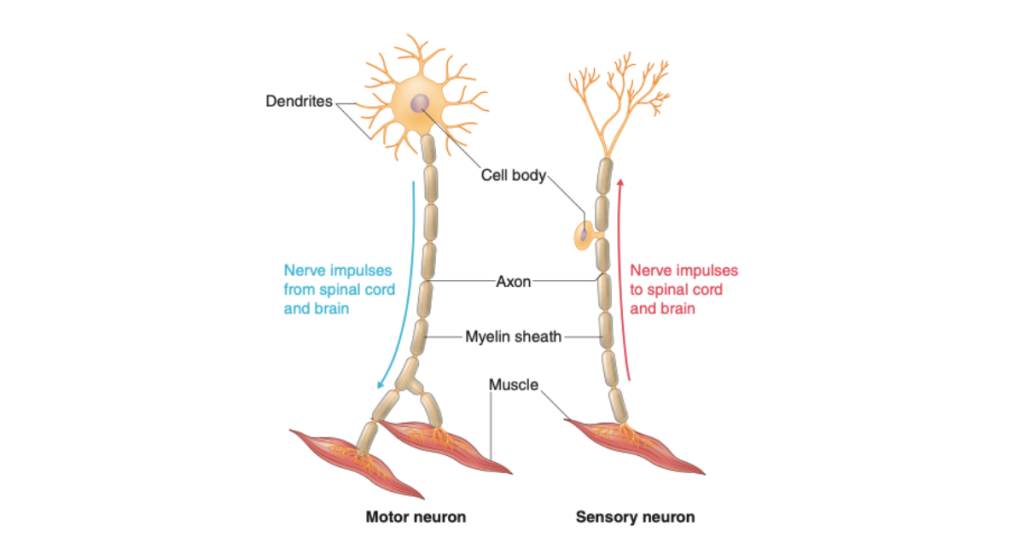
How Sensory and Motor nerves work together:
Sensory and motor neurons provide a basis for automatic or learned reflexes, the simplest kind of action. When the central nervous system receives an emergency sensory impulse, it stimulates quick to action via motor nerves that govern a specific muscle or gland. We withdraw our hands almost instantaneously after touching a hot stove, well before our brains even register the danger. The exact process applies to birds: upon encountering many kinds of danger, a bird’s sensory and motor neurons trigger a flight response before its brain has a chance to process the incident.
Two types of neurons in birds. Sensory neurons bring information (both conscious and unconscious impulses) to the spinal cord and brain. To activate the muscles, motor neurons send impulses from the brain via the spinal cord out to the body.
Can birds feel the wind in their feathers?
It turns out every bird can feel how their feathers move. The feathers don’t have nerves, but they can transmit vibrations down to the skin. Flying birds can sense air flowing over their wings as they fly.
They can tell how fast they fly by how quickly their feathers vibrate. They can feel when air is separating from their wings, leading to a dangerous stall.
One other trick that comes with the ability to feel feathers, is bristles. These are modified feathers that have most of the feathery parts missing. They look like whiskers, and they serve the same function. You’ll see these on many insect-eating birds, and the theory is that if a bug touches those bristles, the bird can sense it and eat it.
This parrot manipulates a nut to eat it. It turns the nut gently, searching for a weak spot. Then it applies up to 1,000 pounds of force [PSI] to the weak spot. The nut bursts open. It applies the right force to break the hard shell without destroying the nut inside. Then, using its feet and tongue, it picks out the good parts while throwing away the shell pieces.
Conclusion: the functions of touch sensitivity in birds
Somatosensory receptors primarily provide information about objects at the body’s surface. They may also provide information on slightly more remote events by detecting the displacement of feathers and bristles. Such types of information are key to the survival of every bird and can also alert the animal to the danger associated with the invasion of their body.
Somatosensory receptors almost certainly provide information about objects taken into the mouth. The presence of these receptors throughout the body suggests that they are also vital for monitoring internal body conditions. The bill-tip organs found in certain bird species show, however, that the somatosensory information can also guide highly specialized behavior in foraging. Crucially, bill-tip organs can make the bill a semi-autonomous tool for actively exploring the environment, not just a device guided by a vision for seizing and manipulating objects. Furthermore, the bill-tip organs of parrots also provide a vital source of specialized information that underpins the use of their bills as a ‘third limb,’ guiding these birds in their exceptional ability to climb, both up and down, in structurally complex situations.